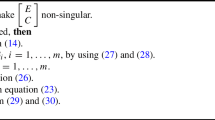Abstract
The problem of stabilization of an autonomous rotorcraft platform in a hover configuration subject to external disturbances is addressed. Necessary and sufficient conditions are presented for static output-feedback control of linear time-invariant systems using the H-Infinity approach. Simplified conditions are given which only require the solution of two coupled matrix design equations. This paper also proposes a numerically efficient solution algorithm for the coupled design equations to determine the output-feedback gain. A major contribution is that an initial stabilizing gain is not needed. The efficacy of the control law and the disturbance accommodation properties are shown on a rotorcraft design example. The helicopter dynamics do not decouple as in the fixed-wing aircraft case, so that the design of helicopter flight controllers with a desirable intuitive structure is not straightforward. In this paper an output feedback approach is given that allows one to selectively close prescribed multivariable feedback loops using a reduced set of the states. Shaping filters are added that improve performance and yield guaranteed robustness and speed of response. This gives direct control over the design procedure and performance. Accurate identification of the System parameters is a challenging task for rotorcraft control, addition of loop shaping facilitates implementation engineers to counteract unmodeled high frequency dynamics. The net result yields control structures that have been historically accepted in the flight control community.
Similar content being viewed by others
References
Basar, T.P., Bernard, P.: Optimal Control and Related Minimax Design Problems, pp. 4–6, 33–48. Birkhauser, Berlin, Germany (1991)
Cao, Y., Lam, J., Sun, Y.: Static output feedback stabilization: an ILMI approach. IFAC J. Automatica 34(12), 1641–1645 (1998). doi:10.1016/S0005-1098(98)80021-6
Chen, B.: Fourth Half Yearly Progress Report for the TYIA 2003 Project on Nonlinear Control Methods for Flight Control Systems of Flying Vehicles, DSTA, NUS, and ST AEROSPACE, Nov. 2005
Chen, B.M.: Robust and H∞ Control. Springer, Berlin (2000)
Colaneri, P., Geromel, J.C., Locatelli, A.: Control Theory and Design, an RH2 and RH∞ Viewpoint, pp. 87–261. Academic Press Interscience, San Diego (1997)
Doyle, J.H., Glover, K., Khargonekar, P., Francis, B.: State-space solutions to standard H2 and H∞ control problems. IEEE Trans. Automat. Contr. 34(8), 831–847 (1989). doi:10.1109/9.29425
El Ghaoui, L., Oustry, F., AitRami, M.: A cone complementarity linearization algorithm for static output-feedback and related problems. IEEE Trans. Automat. Contr. 42(8), 1171–1176 (1997). doi:10.1109/9.618250
Gadewadikar, J., Lewis, F., Abu-Khalaf, M.: Necessary and sufficient conditions for H-∞ static output-feedback control. J. Guid. Control Dyn. 29(4), 915–920 (2006). doi:10.2514/1.16794
Gadewadikar, J., Lewis, F., Xie, L., Kucera, V., Abu-Khalaf, M.: Parameterization of all stabilizing H∞ static state-feedback gains: application to output-feedback design. Automatica 43(9), 1597–1604 (2007) September
Gahinet, P., Nemirovski, A., Laub, A., Chilali, M.: LMI Control Tool Box. MATLAB., Mathworks, Inc., Natick, MA (1995)
Geromel, J.C., Peres, P.L.D.: Decentralized load-frequency control. IEE Proc. 132(D, 5), 225, 230 (1985)
Geromel, J.C., de Souza, C.C., Skelton, R.E.: Static output feedback controllers: stability and convexity. IEEE Trans. Automat. Contr. 43(1), 120–125 (1998). doi:10.1109/9.654912
Hall, W.E. Jr., Bryson, A.E. Jr.: The inclusion of rotor dynamics in controller design for helicopters. J. Aircr. 10(4), 200–206 (1972). doi:10.2514/3.60214
Holl, C., Scherer, C.: Computing optimal fixed order H∞-synthesis values by matrix sum of squares relaxation. In: 43rd IEEE Conference on Decision and Control, Atlantis, Paradise Island, Bahamas, pp. 3147–3153, 2004
Johnson, E.N., Kannan, S.K.: Adaptive trajectory control for autonomous helicopters. AIAA J. Guid. Control Dyn. 28(3), 524–538 (2005)
Johnson, W.: Helicopter Theory. Dover Publications, Mineola, NY (1994)
Kim, Y.H., Lewis, F.L.: High-level Feedback Control with Neural Networks, pp. 55–75. World Scientific, Singapore (1998)
Klienman, D.L.: On an iterative technique for Riccati equations computations. IEEE Trans. Automat. Contr. 13(1), 114–115 (1968)
Knobloch, H.W., Isidori, A., Flockerzi, D.: Topics in control theory, pp. 43–49, 58–67, 99–111. Birkhauser, Berlin, Germany (1993)
Kucera, V., De Souza, C.E.: A necessary and sufficient condition for output feedback stabilizability. IFAC J. Automatica 31(9), 1357–1359 (1995)
Lewis, F.L., Syrmos, V.L.: Optimal Control, 2nd edn., pp. 359–375. Wiley, New York (1995)
Moerder, D.D., Calise, A.J.: Convergence of a numerical algorithm for calculating optimal output feedback gains. IEEE Trans. Automat. Contr. 30(9), 900–903 (1985)
Nakwan, K., Calise, A.J., Corban, J.E., Prasad, J.V.R.: Adaptive Output Feedback for Altitude Control of an Unmanned Helicopter Using Rotor RPM. In: AIAA Guidance, Navigation and Control Conference, August 2004
Prempain, E., Postlethwaite, I.: Static H∞ loop shaping control of a fly-by-wire helicopter. In: 43rd IEEE Conference on Decision and Control, Atlantis, Paradise Island, Bahamas, pp. 1188–1195, 2004
Smerlas, A.J., Walker, D.J., Postlethwaite, I., Strange, M.E., Howitt, J., Gubbels, A.W.: Evaluating. H∞ controllers on the NRC Bell 205 fly-by-wire helicopter. Control Eng. Pract. 9(1), 1–10 (2001). doi:10.1016/S0967-0661(00)00088-5
Stevens, B.L., Lewis, F.L.: Aircraft Control and Simulation, 2nd edn., pp. 403–419. Wiley Interscience, New York (2003)
Syrmos, V.L., Abdallah, C., Dorato, P.: Static output feedback: a survey. In: Proceedings of 33rd IEEE Conference on Decision and Control, Orlando, FL, pp. 837–842, 1994
Trofino-Neto, A., Kucera, V.: Stabilization via static output feedback. IEEE Trans. Automat. Contr. 38(5), 764–765 (1993)
Linda, W., Suresh, K.K., Sander, S., Guler, M., Heck, B., Prasad, J.V.R., Schrage, D.P., Vachtsevanos, G.: An open platform for reconfigurable control. In: Samad, T., Balas, G.J. (eds.) Software-Enabled Control: Information Technology for Dynamical Systems. IEEE Press, Piscataway (2001)
Zames, G.: Feedback and optimal sensitivity: model reference transformations, multiplicative seminorms, and approximate inverses. IEEE Trans. Automat. Contr. 26(2), 301–320 (1981). doi:10.1109/TAC.1981.1102603
Author information
Authors and Affiliations
Corresponding author
Rights and permissions
About this article
Cite this article
Gadewadikar, J., Lewis, F.L., Subbarao, K. et al. H-Infinity Static Output-feedback Control for Rotorcraft. J Intell Robot Syst 54, 629–646 (2009). https://doi.org/10.1007/s10846-008-9279-5
Received:
Accepted:
Published:
Issue Date:
DOI: https://doi.org/10.1007/s10846-008-9279-5




